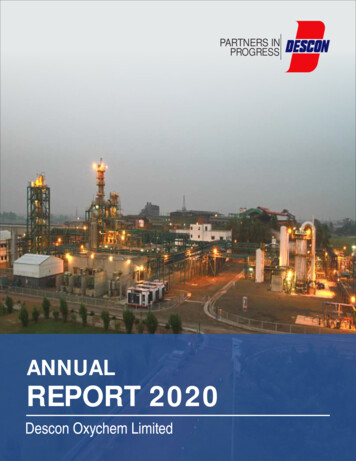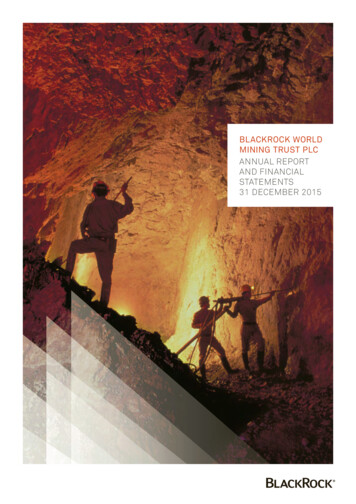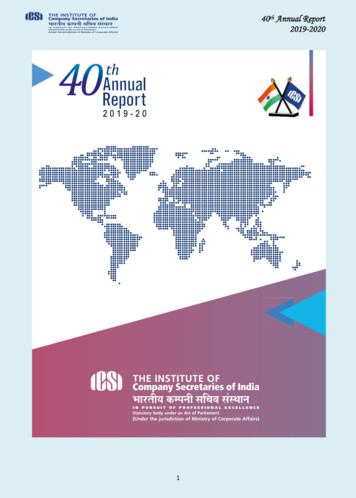
Transcription
2020 Annual Financial Report
Board of Trustees and Administration1Auditor’s Opinion2Management Discussion and Analysis5Financial Statements13Notes to the Financial Statements19Required Supplementary Information57
ANNUAL FINANCIAL REPORT FOR JUNE 30, 2020BOARD OF TRUSTEESADMINISTRATIONKaren Fraser (Chair)OlympiaGeorge S. BridgesPh.D., University of PennsylvaniaPresidentFred Goldberg (Vice Chair)OlympiaIrene Gonzales (Secretary)NewportMonica AlexanderTacomaDavid NicandriTumwaterMiguel Pérez-GibsonOlympiaEd ZuckermanSeattleLucera Cox (Student Trustee)OlympiaJohn CarmichaelPh.D., Colorado State UniversityVice President for Finance and OperationsJennifer DrakePh.D., State University of New York at BinghamtonProvost and Vice President for Academic AffairsTherese SalibaPh.D., University of WashingtonInterim Vice President for Inclusive Excellence andStudent SuccessSandra KaiserB.A., San Francisco State UniversityVice President for College RelationsTina Kuckkahn-MillerJ.D., University of Wisconsin Law of SchoolVice President for Indigenous Arts and EducationAmanda WalkerM.A., University of YorkVice President for Advancement
Office of the Washington State AuditorPat McCarthyINDEPENDENT AUDITOR’S REPORT ON THE FINANCIAL STATEMENTSBoard of TrusteesThe Evergreen State CollegeOlympia, WashingtonREPORT ON THE FINANCIAL STATEMENTSWe have audited the accompanying financial statements of the business-type activities and the aggregatediscretely presented component units of The Evergreen State College, as of and for the year endedJune 30, 2020, and the related notes to the financial statements, which collectively comprise theCollege’s basic financial statements as listed in the table of contents.Management’s Responsibility for the Financial StatementsManagement is responsible for the preparation and fair presentation of these financial statements inaccordance with accounting principles generally accepted in the United States of America; this includesthe design, implementation, and maintenance of internal control relevant to the preparation and fairpresentation of financial statements that are free from material misstatement, whether due to fraud orerror.Auditor’s ResponsibilityOur responsibility is to express opinions on these financial statements based on our audit. We did notaudit the financial statements of The Evergreen State College Foundation (the Foundation), whichrepresents 100 percent of the assets, net position and revenues of the aggregate discretely presentedcomponent unit. Those statements were audited by other auditors, whose report has been furnished tous, and in our opinion, insofar as it relates to the amounts included for the Foundation, is based solelyon the report of the other auditors. We conducted our audit in accordance with auditing standardsgenerally accepted in the United States of America and the standards applicable to financial auditscontained in Government Auditing Standards, issued by the Comptroller General of the United States.Those standards require that we plan and perform the audit to obtain reasonable assurance about whetherthe financial statements are free from material misstatement. The financial statements of the Foundationwere not audited in accordance with Government Auditing Standards.An audit involves performing procedures to obtain audit evidence about the amounts and disclosures inthe financial statements. The procedures selected depend on the auditor’s judgment, including the
assessment of the risks of material misstatement of the financial statements, whether due to fraud orerror. In making those risk assessments, the auditor considers internal control relevant to the College’spreparation and fair presentation of the financial statements in order to design audit procedures that areappropriate in the circumstances, but not for the purpose of expressing an opinion on the effectivenessof the College’s internal control. Accordingly, we express no such opinion. An audit also includesevaluating the appropriateness of accounting policies used and the reasonableness of significantaccounting estimates made by management, as well as evaluating the overall presentation of the financialstatements.We believe that the audit evidence we have obtained is sufficient and appropriate to provide a basis forour audit opinions.OpinionsIn our opinion, based on our audit and the report of the other auditors, the financial statements referredto above present fairly, in all material respects, the respective financial position of the business-typeactivities and the aggregate discretely presented component units of The Evergreen State College, as ofJune 30, 2020, and the respective changes in financial position and, where applicable, cash flows thereoffor the year then ended in accordance with accounting principles generally accepted in the United Statesof America.Matters of EmphasisAs discussed in Note 1, the financial statements of The Evergreen State College, an agency of the stateof Washington, are intended to present the financial position, and the changes in financial position, andwhere applicable, cash flows of only the respective portion of the activities of the state of Washingtonthat is attributable to the transactions of the College and its aggregate discretely presented componentunits. They do not purport to, and do not, present fairly the financial position of the state of Washingtonas of June 30, 2020, the changes in its financial position, or where applicable, its cash flows for the yearthen ended in conformity with accounting principles generally accepted in the United States of America.Our opinion is not modified with respect to this matter.Other MattersRequired Supplementary InformationAccounting principles generally accepted in the United States of America require that the management’sdiscussion and analysis and required supplementary information listed in the table of contents bepresented to supplement the basic financial statements. Such information, although not a part of the basicfinancial statements, is required by the Governmental Accounting Standards Board who considers it tobe an essential part of financial reporting for placing the basic financial statements in an appropriateoperational, economic or historical context. We have applied certain limited procedures to the requiredsupplementary information in accordance with auditing standards generally accepted in the United Statesof America, which consisted of inquiries of management about the methods of preparing the information
and comparing the information for consistency with management’s responses to our inquiries, the basicfinancial statements, and other knowledge we obtained during our audit of the basic financial statements.We do not express an opinion or provide any assurance on the information because the limitedprocedures do not provide us with sufficient evidence to express an opinion or provide any assurance.Other InformationOur audit was conducted for the purpose of forming opinions on the financial statements that collectivelycomprise the College’s basic financial statements as a whole. The list of Board of Trustees andAdministration is presented for purposes of additional analysis and is not a required part of the basicfinancial statements of the College. Such information has not been subjected to the auditing proceduresapplied in the audit of the basic financial statements and, accordingly, we do not express an opinion orprovide any assurance on it.OTHER REPORTING REQUIRED BY GOVERNMENT AUDITING STANDARDSIn accordance with Government Auditing Standards, we will also issue our report dated July 29, 2021,on our consideration of the College’s internal control over financial reporting and on our tests of itscompliance with certain provisions of laws, regulations, contracts and grant agreements and othermatters. The purpose of that report is to describe the scope of our testing of internal control over financialreporting and compliance and the results of that testing, and not to provide an opinion on internal controlover financial reporting or on compliance. That report is an integral part of an audit performed inaccordance with Government Auditing Standards in considering the College’s internal control overfinancial reporting and compliance.Sincerely,Pat McCarthy, State AuditorOlympia, WAJuly 29, 2021
MANAGEMENT'S DISCUSSION AND ANALYSISThe Evergreen State CollegeThe following discussion and analysis provides an overview of the financial position and activities of TheEvergreen State College (the College) for the fiscal years (FY) ended June 30, 2020 and June 30, 2019.Management’s Discussion and Analysis (MD&A) provides the readers an objective and easily readableanalysis of the College’s financial performance for the year, based on currently known facts andconditions. This discussion has been prepared by management and should be read in conjunction withthe financial statements and accompanying notes.Reporting EntityThe Evergreen State College is one of six state-assisted, four-year public institutions of higher educationin the state of Washington, providing baccalaureate and graduate educational programs to approximately2,500 students. The College was established in 1967, and its primary purpose is to prepare individuals forsuccessful contributions to society through their careers and in their leadership roles as citizens.The College’s campus is located in Olympia, Washington, a community of approximately 46,500 residents.The College also has operations in Tacoma and along the Olympic Peninsula on the Quinault IndianReservation. The College is governed by an eight-member Board of Trustees appointed by the governorof the state with the consent of the state Senate. One of the members is a full-time student of the College.By statute, the Board of Trustees has full control of the College and its property of various kinds, exceptas otherwise provided by law.Using the Financial StatementsThe College reports as a business-type activity as defined by Governmental Accounting Standards Board(GASB) Statement No. 35, Basic Financial Statements—and Management’s Discussion and Analysis—forPublic Colleges and Universities, as amended. Under this model, the financial report consists of threefinancial statements, the Statement of Net Position, the Statement of Revenues, Expenses and Changesin Net Position and the Statement of Cash Flow. The Statement of Net Position provides information aboutthe College at a moment in time, the June 30 fiscal year end. The Statement of Revenues, Expenses, andChanges in Net Position and the Statement of Cash Flows provide information about the College’sactivities and operations during the fiscal year. The financial statements, in conjunction with the Notes tothe Financial Statements, provide a comprehensive way to assess the College’s financial health. Thefinancial statements are prepared in accordance with accounting principles generally accepted in theUnited States of America.GASB Statement No. 39, Determining Whether Certain Organizations are Component Units requires anorganization to report an organization that raises and holds economic resources for the direct benefit ofa government unit as a component unit. Under this requirement, The Evergreen State College Foundationis a component unit of the College and the foundation’s financial statements and the notes to theirfinancial statements are incorporated in this financial report.THE EVERGREEN STATE COLLEGE 2020 ANNUAL FINANCIAL REPORT
MANAGEMENT'S DISCUSSION AND ANALYSISStatements of Net PositionsThe Statements of Net Positions provides information about the College’s financial position, and presentsthe College’s assets, liabilities, and net positions at year-end.A condensed comparison of the Statements of Net Positions as of June 30, 2020 and 2019 follows:Condensed Statements of Net PositionsAs of June 30 (in thousands)AssetsCurrent assetsCapital, netOther non-current assetsTotal AssetsDeferred OutflowsLiabilitiesCurrent liabilitiesOther non-current liabilitiesTotal LiabilitiesDeferred InflowsTotal Net Position20202019 39,664183,3615,836228,8617,969 ,75011,76362,68874,45118,245 142,459 147,304AssetsThe major components of assets are cash, receivables and capital assets. Total assets decreased by 6.2million from FY 2019 to FY 2020.Current assets consist primarily of cash, short-term investments, receivables and inventories. Currentassets decreased by 2.8 million from FY 2019 to FY 2020, primarily the result of a 4.9 million decreasein cash and cash equivalents offset by an increase of 1.3 million in Due from State Treasurer and 1.1million increase in accounts receivable. The decrease in cash was primarily caused by the impact of COVID19 on revenues in Spring quarter when many students withdrew from classes and canceled their housingand dining contracts. The increase of funds Due from the State Treasurer was expected because FY 2020was the first year of the biennium when capital projects are funded increasing the amount of capitalmoney held by the State Treasurer’s Office. The increase in receivables was primarily due to 1.2 millionof federal CARES Act funding due to the college for lost revenue and COVID related expenditures throughyear end.Capital assets decreased in FY 2020 by about 3.1 million. During the year, the college continued toincrease infrastructure projects and added 7.1 million of construction in progress costs while writing off 2.7 million in construction in progress expenses due to the decision to not pursue the construction ofnew dormitories at this time. In addition, the college added nearly 390 thousand of capital equipmentand recorded current year depreciation of 7.8 million.THE EVERGREEN STATE COLLEGE 2020 ANNUAL FINANCIAL REPORT
MANAGEMENT'S DISCUSSION AND ANALYSISDeferred outflows increased by about 3 million and are primarily related to implementation of GASBStatements 68, 73 and 75. The College uses the Participating Employer Financial Information reportprepared by the state Department of Retirement Services to determine deferred outflows. Deferredoutflows consist primarily of retirement and Other Post-Employment Benefits (OPEB) contributions madeafter the measurement date and differences between expected and actual experience.LiabilitiesThe excess of current assets over current liabilities of 25.8 million, a year-over-year decrease of 4.9million from FY 2019. Even with this decrease, the College has a current ratio of 2.86 to 1, indicating itsability to continue to easily meet its short-term obligations with liquid or easily liquidated assets. Currentliabilities typically fluctuate depending on the timing of payments and the receipt of deposits and revenuethat is applicable to the next fiscal year.Liabilities include amounts payable to suppliers for goods and services, accrued payroll, leave and relatedliabilities, debt, deposits held for others, unearned revenue and pension expenses.Current liabilities increased by 2.1 million from FY 2019 to FY 2020. The increase was primarily due to a 1.5 million increase in accounts payable, mostly the result of payments due to contractors working onthe critical power, safety and security system of 785 thousand and the Lab 1 Seismic and HVACrenovation projects of 667 thousand.Noncurrent liabilities decreased by 946 thousand primarily the result of increases in pension and OPEBliabilities due to changes in GASB No. 68, 73 and 75 of 546 thousand offset by a decrease in long-termdebt of 1.5 million.Deferred inflows relate primarily to implementation of GASB Statements 68, 73, and 75 increased by 505,000 mostly, due to changes in actuarial assumptions used to calculate the liabilities and differencesbetween projected and actual investment earnings on applicable plan assets.Net PositionNet position represents the difference between the College’s assets and deferred outflows, less liabilitiesand deferred inflows. The change in net position measures whether the overall financial condition hasimproved or deteriorated during the year and is driven by the difference between revenues and expenses.Net position decreased by 4.8 million in FY 2020, ending at 142.5 million.The College reports its net position in four categories:Invested in Capital Assets (Net of Related Debt) –This is the College’s total investment in property, plant, equipment, and infrastructure net of accumulateddepreciation and outstanding debt obligations related to those capital assets (See Note 6).Restricted Net Position-Expendable –This consists of resources in which the College is legally or contractually obligated to spend in accordancewith restrictions placed by donor and/or external parties that have placed time or purpose restrictions onthe use of the asset. The primary expendable funds for the College are student loans, capital projectsfunds and the expendable portion of endowments.THE EVERGREEN STATE COLLEGE 2020 ANNUAL FINANCIAL REPORT
MANAGEMENT'S DISCUSSION AND ANALYSISNon-Expendable –Consists of funds in which the donor or external party has imposed the restriction that the corpus orprincipal is not available for expenditures but for investment purposes only.Unrestricted Net Position –These are all the other funds available to the College for the general and educational obligations to meetcurrent expenses for any lawful purpose. Unrestricted net position assets are not subject to externallyimposed stipulations; however, the College has designated the majority of unrestricted net position forvarious academic and college support functions. This is also the net position classification most affectedby the implementation of GASB pronouncements regarding account and reporting of long-term liabilities.Evergreen’s net position as of June 30, 2020 and 2019 are summarized as follows:Condensed Net PositionsAs of June 30 (in thousands)Invested in capital assets, net of related debtRestricted:PensionsNon-expendable: Scholarships andProfessorshipsExpendableUnrestrictedTotal net position20202019 164,336 165,9648006442,1554,213(29,045) 142,4592,1555,793(27,252) 147,304Statements of Revenues, Expenses and Changes in Net PositionsThe Statement of Revenues, Expenses and Changes in Net Positions presents the detail of the changes oftotal net position for the College. The objective of the statement is to provide information about theoperating performance of the College by presenting the revenue and expenditures, both operating andnon-operating, along with any other revenue, expenses, gains and losses of the College. Generally,operating revenues are revenues earned by the College in exchange for providing goods and services.Operating expenses are defined as expenses incurred in the normal operation of the College, including aprovision for allowance of depreciation on property and equipment assets. The difference betweenoperating revenues and operating expenses is the operating loss. The College will always be expected toshow an operating loss since state appropriations are shown as non-operating revenues as required bythe Governmental Accounting Standards Board (GASB), the rule setting body for accounting standardsapplied to the College.A summary of the College’s Statements of Revenues, Expenses and Changes in Net Positions for the YearsEnded June 30, 2020 and 2019 follows:THE EVERGREEN STATE COLLEGE 2020 ANNUAL FINANCIAL REPORT
MANAGEMENT'S DISCUSSION AND ANALYSISCondensed Statements of Revenues, Expenses, and Changes in Net PositionsFor the years ended June 30 (in thousands)2020Operating revenues (by major source)Operating expensesNet operating lossNon-operating revenues (by major source)Gain(loss) before other revenuesOther revenues and expensesIncrease in net assetsNet assets at beginning of year 48,922100,492(51,570)43,295(8,275)4,171(4,104)2019 304149,661Prior Period Adjustment(740)-Net assets at end of year 142,459 147,304Operating and Non-operating RevenuesOperating revenues consist primarily of tuition and fees (net of scholarship discounts and allowances),grants & contracts, and sales and services revenue generated by auxiliary enterprises and other supportoperations. Non-operating revenues consist primarily of state appropriations, investment income andPell grants for student financial aid. Other revenues and expenses are derived almost entirely from statecapital appropriations.In FY 2020, the College’s operating revenue decreased by 9.2 million.Net tuition revenues (tuition and fees less scholarship allowances) decreased by 3.6 million compared toFY 2019. The decrease was the result of declining enrollments and refunds of tuition to studentswithdrawing from Spring quarter due to the pandemic. To address the decline in tuition revenues, theCollege has developed an aggressive “Renewal Plan” designed to increase both recruitment and retentionofstudents.Auxiliary revenue decreased by 3.1 million primarily due to the pandemic which led to the collegerefunding Spring quarter room and board, tuition and other fees. Additionally, the requirements to socialdistance and stay at home resulting in lost revenue to conference services and the bookstore.State and local grants and contracts decreased by 1.1 million primarily because lower enrollmentresulted in fewer students being eligible for the state need grant and the state work study program. As aresult, the college received 800 thousand less for the state need grant and 150 thousand less for thework study program.Non-operating revenues increased in FY 2020 by 2.6 million primarily due to an increase in stateappropriations of 3.5 million to cover legislatively approved compensation and other state mandatedTHE EVERGREEN STATE COLLEGE 2020 ANNUAL FINANCIAL REPORT
MANAGEMENT'S DISCUSSION AND ANALYSISoperating increases and 1.2 million of federal CARES Act money to reimburse the college for COIVDrelated expenses and lost revenues as a result of the pandemic. These increases were offset by a decreaseof 2.5 million for the Federal Pell grant program due to decreased enrollments resulting in fewer studentsbeing eligible for the program.The following graph and table reflect the percentage of revenue received by source of revenue:FY 2020 Revenue by Source7% 3% 2%22%35%Student tuition and fees,netGrants & contractsAuxiliary servicesState appropriations operatingState appropriations capitalInvestment incomeOther revenues23%8%Revenues by SourceFor the years ended June 30, 2020and 2019(in thousands)Student tuition and fees, netGrants & contractsAuxiliary servicesState appropriations - operatingState appropriations - capitalInvestment incomeOther revenuesTotal revenues2020 22,165 22%23,221 23%7,7218%34,306 35%6,903 7%3,319 3%2,378 2% 100,013 100%2019 25,76128,06811,31030,8382,5341,977867 101,35525%28%11%30%3%2%1%100%Operating ExpensesIn 2020, the College’s total operating expenses decreased by about 3.2 million. The largest decrease wasin employee benefits of 1.6 million and 2.3 million in supplies and materials. The largest increase wasa 2.4 million increase in scholarships and fellowships.THE EVERGREEN STATE COLLEGE 2020 ANNUAL FINANCIAL REPORT
MANAGEMENT'S DISCUSSION AND ANALYSISThe graph below reflects the percentage of operating expenses by object:FY 2020 Expenses by Object3%2%7%46%Salaries & wages13%BenefitsScholarship and fellowshipsSupplies & materialsDepreciationPurchased services16%Utilities13%Operating Expenses By Object (in thousands)For the years ended June 30, 2020 and 2019Salaries & wagesBenefitsScholarship and fellowshipsSupplies & materialsDepreciationPurchased servicesUtilitiesTotal Expenses2020 45,91212,84615,97513,1127,8062,9541,888 100,49346%13%16%13%7%3%2%100%2019 2,2792% 103,712 100%Capital AssetDuring FY 2020 the College continued to increase its investment in capital assets. Ongoing projects at theend of the year include: The construction of a new Health and Counseling Center that is expected to be completedduring FY21.The renovation of the HVAC system in Lab 1.A critical power project to upgrade current systems making them safer.The development of an infrastructure master plan.THE EVERGREEN STATE COLLEGE 2020 ANNUAL FINANCIAL REPORT
MANAGEMENT'S DISCUSSION AND ANALYSISIn accordance with the College’s 10-year Facilities Master Plan, the College will continue to invest in thedevelopment of new capital assets, capital improvements and preservation of the infrastructure of stateassets.Financial Summary and Economic Factors That Will Affect the FutureThe Washington State Economic and Revenue Forecast Council’s June 2020 estimate of state general fundrevenues indicated a decrease of 4.5 billion for the current 2019-21 biennium and 4.4 billion in the2021-23 biennium. The decreased forecast is attributed to the economic disruption caused by the COVID19 pandemic. Subsequent forecasts in September and November 2020 increased the 2019-21 and 202123 forecasts by 2.7 billion and 2.5 billion respectively, primarily due to higher-than-expected revenuecollections in the sectors of retail trade and real estate.Last spring, in response to declining state revenues, the Governor’s Office of Financial Managementdirected all state agencies, including higher education institutions, to identify operating budget savingsfor FY 2021 equal to 15% of current appropriations. Potentially permanent appropriation reductions maybe enacted during the 2021 Legislative session that convened in January 2021.The COVID-19 pandemic has impacted other non-state appropriated operating revenues as well.Undergraduate and graduate tuition rates were increased for the 2020-21 academic year, but enrollmentdeclines are expected to offset any increase in net tuition revenue associated with the rate increase.Significant and unprecedented revenue losses are expected in auxiliary activities due to reducedoccupancy in student housing and COVID-19 restrictions on gatherings.The college has addressed the economic challenges in a few ways including reduction of unit operatingbudgets, hiring & purchasing freezes, not providing salary increases to exempt non-represented staff, andimplementing furloughs for all staff and faculty. These efforts combined with continued assessment andplanning will help guide the college’s response to the fiscal impact caused by the pandemic. Even withthese efforts, the college expects the COVID-19 pandemic revenue losses to negatively impact reserves.The State provided funding to implement the legislatively approved 3% annual compensation increase forall College employees in both fiscal years of the 2019-21 biennium. The legislature also invested in theCollege’s Psychology program by providing funding to increase faculty to address the increased interestin the program.For the 2019-21 biennium, the legislature authorized a new dedicated revenue source for publicinstitutions of higher education, the Workforce Education Investment Account that dramatically expandsthe amount of state support for low income college students who are Washington residents. Thisadditional aid should help increase the number of students attending Evergreen.The 2019-21 biennial capital budget includes funding to create new space for a student health care center,address HVAC and seismic issues in aging building and to create a sustainable master plan for campusutilities.Enrollment has been declining for the past several years which the College is addressing through theimplementation of a robust three-year renewal plan. However, if enrollments continue to decline theCollege could continue to experience a decline in tuition revenue.THE EVERGREEN STATE COLLEGE 2020 ANNUAL FINANCIAL REPORT
The Evergreen State CollegeStatement of Net PositionJune 30, 20202020AssetsCurrent AssetsCash and cash equivalentsDue from State TreasurerFunds held with State TreasurerAccounts receivable, netStudent loan receivables, netInventoriesTotal current assetsNon-Current AssetsRestricted InvestmentsStudent Loan Receivables, netNet Pension AssetCapital Assets, net of depreciationTotal non-current assetsTotal assetsDeferred OutflowsRelating to pensionRelated to OPEBDeferred Outflow on RefundingsTotal deferred outflowsLiabilitiesCurrent LiabilitiesAccounts Payable and Accrued ExpensesUnearned RevenuesDeposits PayableCompensated AbsencesCurrent portion, Total OPEB Liability Current portion, Total Pension LiabilityCurrent portion of bonds and notes payableTotal current liabilities Non-Current LiabilitiesCompensated AbsencesTotal Pension Liability (GASB 73)Total OPEB Liability (GASB 75)Net Pension Liabilities (GASB 68)Long Term DebtTotal non-current liabilitiesTotal liabilitiesDeferred InflowsRelating to pensionRelating to OPEB (GASB 75)Total deferred inflowsNet PositionNet Investment in capital assetsRestricted for:PensionsNonexpendable:Scholarships and professorshipsExpendable:LoansEndowment earningsUnrestrictedTotal net position 1,492,27713,878,435 2,795 75,621,230 5,505,52813,244,48818,750,016 ,521) See Accompanying Notes to the Financial Statements.142,459,416
THE EVERGREEN STATE COLLEGE FOUNDATIONStatement of Financial PositionYear Ended June 30, 2020ASSETS2020CURRENT ASSETSCash, including restricted cashInvestment cashBeneficial interest in lead trustUnconditional promises to give, currentOther receivables Total Current Assets4,555,348OTHER ASSETSInvestmentsBeneficial interest in lead trustLong-term unconditional promises to give16,098,0591,265,368318,783Total Other AssetsTotal Assets2
for the year then ended in accordance with accounting principles generally accepted in the United States of America. Matters of Emphasis As discussed in Note 1, the financial statements of The Evergreen State College, an agency of the state of Washington, are intended to present the financial position, and the changes in financial position, and










